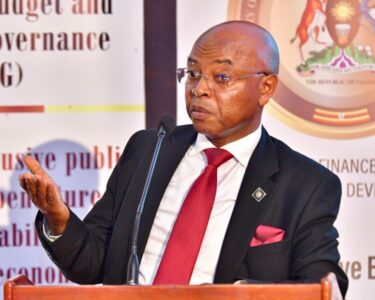By Business Times Writer | August 20, 2025
Stanbic Uganda Holdings Limited (SUHL), the country’s largest financial services group, has announced strong results for the first half of 2025, posting a profit after tax of UGX 278 billion and contributing UGX 273 billion in taxes to the national treasury. These numbers, though impressive in their own right, tell a much bigger story — one of resilience, trust, and a deliberate strategy to align banking with Uganda’s broader development goals.
For many, banks are often judged by balance sheets and profitability. But Stanbic’s latest performance, marking an 18 percent rise in profits compared to the same period last year and a 37 percent increase in tax contributions, reveals an institution that is striving to go beyond financial numbers. It shows a bank determined to anchor itself at the heart of Uganda’s economic journey, supporting not just shareholders but farmers, women entrepreneurs, youth innovators, and small businesses across the country.

Chief Executive Officer of SUHL, Francis Karuhanga, reflected on this dual role when announcing the results. “Our strong half-year performance reflects sound execution and resilience in a challenging environment. Paying UGX 273 billion in taxes is not just a statutory obligation—it is a clear demonstration of how our commercial success translates into tangible support for Uganda’s fiscal objectives,” he said. He added that the bank had also facilitated more than UGX 5.8 trillion in tax collections on behalf of the Uganda Revenue Authority through its banking platforms, effectively making Stanbic a critical enabler of domestic resource mobilization.
For Karuhanga, the tax contribution is not simply a financial milestone but also a statement of national responsibility. “Our role is to help build the nation’s capacity, not only by growing our business but also by ensuring that government has the resources to fund infrastructure, healthcare, and education. We see ourselves as partners in development, not just financial intermediaries.”
The group’s strong half-year performance was driven by its anchor subsidiary, Stanbic Bank Uganda, which posted solid growth across all its divisions. Chief Executive, Mumba Kalifungwa, pointed to innovation, customer-centric solutions, and disciplined risk management as the key drivers of success. The Corporate and Investment Banking arm registered a 17 percent increase in lending and a 52 percent rise in deposits. At the same time, the Personal and Private Banking and Business and Commercial Banking segments also recorded healthy growth, reflecting the broad appeal of the bank’s offerings.
But more important than percentages were the targeted investments Stanbic made in areas critical to Uganda’s socio-economic progress. Kalifungwa revealed that the bank had injected UGX 288 billion in new capital into local businesses, raising its SME loan book to UGX 968 billion. Of this, UGX 144 billion was directed specifically to women-owned enterprises, while UGX 65 billion was extended to smallholder farmers. Agriculture, which employs the majority of Ugandans, received a cumulative UGX 398 billion in financing. “These are not just figures,” Kalifungwa explained. “They represent thousands of livelihoods being uplifted, schools being built, exports being strengthened, and communities becoming more resilient. They are proof points of how we are aligning our strategy with the national growth agenda.”
In fact, the deliberate focus on women entrepreneurs is one of the standout features of Stanbic’s strategy. Women-owned businesses in Uganda often face greater hurdles in accessing credit compared to their male counterparts, yet they are proven drivers of household welfare and community development. By channeling UGX 144 billion into such enterprises, Stanbic is directly contributing to women’s economic empowerment—a cornerstone of inclusive growth. Similarly, financing smallholder farmers has ripple effects across the agricultural value chain, ensuring food security while enhancing export competitiveness.
From the perspective of Ronald Makata, the Chief Financial and Value Management Officer, Stanbic’s performance was also about discipline and efficiency. “Our cost-to-income ratio remains well below 50 percent, credit losses have been tightly managed at just 0.2 percent, and our return on equity stands at 27 percent. These metrics show a diversified, resilient business model that can weather uncertainty while still delivering value to shareholders,” he said. He pointed out that revenues grew by 7.5 percent, driven by a 12.9 percent expansion in loans and advances, increased working capital utilization, and improved activity in custody and investment services. Deposits grew by nearly 29 percent, the strongest in years, signaling renewed client confidence in the bank’s value proposition.
While Stanbic’s executives spoke extensively about growth, risk management was a recurring theme. Kalifungwa underscored that in an era of digital banking and global interconnectedness, cybersecurity and operational resilience are non-negotiables. “We are investing significantly in systems and people to manage risk, because trust is the foundation of banking. Without robust resilience, the gains we’ve made in growth and innovation could quickly unravel,” he noted.
Yet what truly differentiates Stanbic is its philosophy of banking as a force for good. Its support to SMEs, youth, women, and farmers is not merely philanthropy but a recognition that sustainable profitability is only possible if the wider economy is thriving. For instance, through the Stanbic Business Incubator, the group provides training and capacity building to local entrepreneurs, enabling them to compete for opportunities in sectors like oil and gas, construction, and manufacturing. By building stronger businesses, Stanbic indirectly builds a stronger Uganda.
One of the stories that illustrates this impact is that of Grace Namirembe, a smallholder farmer from Luwero who accessed a loan under Stanbic’s agriculture financing portfolio. With UGX 15 million in credit, she was able to acquire irrigation equipment, expand her tomato farm, and hire more workers. Today, she supplies produce to Kampala markets and employs 12 young people in her community. “Without Stanbic’s loan, I would still be farming on a very small scale. They trusted me when many others said no, and now my farm is not just feeding my family but providing jobs to others,” she said.
Similar stories abound in the SME sector, where small businesses are scaling up with Stanbic’s support. In Gulu, Northern Logistics Ltd, a women-owned enterprise, secured financing to expand its transportation fleet. The company, which started with just two trucks, now operates 12, servicing markets across northern Uganda and South Sudan. Its founder, Alice Akello, credits Stanbic for believing in her vision. “Accessing capital as a woman in business is never easy, but Stanbic saw the potential. We are now employing 35 people, most of them youth, and contributing to cross-border trade,” she said.
These stories underscore what Karuhanga meant when he described Stanbic’s work as a blend of business and nation-building. “We are confident of delivering continued attractive growth and increased returns, but we are equally committed to ensuring that growth is inclusive. Finance must be a force for good,” he reiterated.
Looking ahead, the group intends to consolidate its strong half-year momentum, deepen investment in priority sectors, and leverage its position as part of Standard Bank Group—the largest lender in Africa by assets—to bring global expertise to local challenges. The focus will be on scaling innovation, broadening access to financial services, and continuing to prioritize women, youth, and farmers as central pillars of its growth strategy.
Stanbic Uganda Holdings Limited is listed on the Uganda Securities Exchange and includes four subsidiaries: Stanbic Bank Uganda, SBG Securities, Stanbic Properties Limited, and the Stanbic Business Incubator. Each plays a distinct role in the group’s vision of “Driving Uganda’s Growth.” Collectively, they embody an institution that is not only financially strong but also deeply invested in the nation’s prosperity.
The numbers from the first half of 2025 may speak of profit and tax contributions, but behind them are thousands of individual stories—entrepreneurs scaling up, farmers increasing yields, women breaking barriers, and youth finding employment. As Stanbic Uganda celebrates its strong half-year results, it is these stories of progress and inclusion that truly define its impact on Uganda’s economic and social landscape.






